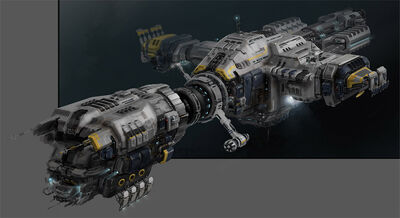 |
WARNING: This document, UNSC Aeneas, is property of the UNSC and is Classified [NOVEMBER BLACK], protected under Office of Naval Intelligence Security Protocol 1A. Disclosure of its contents to, or access or alteration by, personnel with a clearance level lower than GAMMA THREE is an offense punishable by court(s) martial and imprisonment or execution for treasonous acts. Failure to disclose confirmed or suspected breaches of security will be treated as complicity, and is punishable by dishonourable discharge and/or imprisonment. Lieutenant Commander Michael Pomare, Office of Naval Intelligence, UNSCDF Navy |
 |
| |||||||||||||||||||||||||||||||||||||||||||||||||||||||||
| [Source] | |||||||||||||||||||||||||||||||||||||||||||||||||||||||||
- "Alea Iacta Est"
- ―Ship motto
One of only five Herald-class ships still in service with the UNSC Navy, the Aeneas holds the distinction of being one of the oldest operational ship classes, predating the Phoenix-class colony ships by more than sixty years. For much of its history, it served as a colony ship under civilian ship captains, transporting colonists and terraforming gear to newly established colonies, and has been scheduled for decommission several times, always saved at the last moment for refit and upgrade. Currently part of the UNSC 30th Fleet, the Aeneas is mostly remembered for its performance in the Minorca theatre of combat.
Commission[]
A member of the Herald-class, the Aeneas was commissioned in 2411 after the launch of the first two ships of its class, the UNSC Herald and the UNSC Mercury. Over the ten years of construction, the Aeneas encountered numerous problems, delaying its completion significantly. Structural defects in the vanadium internal bracings were detected, forcing them to be replaced. Protests over the proposed Orion nuclear propulsion drive led to its replacement with conventional rocket thrusters. Corners were cut by engineers during the installation of the reactors and thrusters, beginning an inquiry into corruption within the designer company, Sierra Space Systems, resulting in the arrest of fourteen highly placed members of the corporation and its near bankruptcy. Further testing revealed serious faults with the ships electronics, requiring complete replacement. It was eventually completed, alongside another twenty nine other ships of the class, and launched on February 13th with much fanfare from the Reyes-McLees Naval Shipyards, its name drawn from a Roman mythological hero – a survivor of the sack of Troy and the founder of the Roman empire, a fitting name for a colony ship.
Its construction was the subject of much debate among civilian naval operators, who regarded the replacement of the popular Odysseus-class as an affront to civilian colonisation efforts. Worse still was the fact that it was commissioned by the UNSC Navy, rather than one of the many independent colonisation corporations, and it led to speculation of military encroachment upon the colonisation efforts of the UNSC. Despite the correction of numerous flaws through the Aeneas’ commission, others quickly surfaced, some serious and life-threatening. Numerous refits throughout the Aeneas’ civilian service attempted to correct these, but it continued to attract a reputation as an unwieldy, temperamental, and dangerous ship until it was acquired by the military. Most of the more serious events were covered up by Sierra Space Systems, but have come to light with the release or leak of documents about the company’s pathetic level of concern for employee safety.
History[]
Civilian Service[]
Serving under its first commanding officer, Captain Horatio Cain, the Aeneas colonised seven star systems, transporting thousands of colonists and terraforming equipment to the settlements. While most colony ships of the time were designed as disposable transports, meant to be dismantled and used as the basis for the first settlements, Sierra Space Systems advertised their ships as continuously serving transports, though they were not designed as such. Making numerous back-and-forth trips between star systems, the Aeneas transported thousands of settlers to new colonies. In 2432, its first major accident occurred – a hangar bay seal failed, venting the entire payload, including cryonic storage canisters for colonists, into space. Initially, the captain attempted to report this to the Department of Colonial Affairs, but was blocked by the company, who were in financial difficulties and not eager for the negative publicity. Filing several complaints, he finally resigned, intending to inform the DCA and provide evidence against the company. He was killed in a freak accident, his shuttle colliding with a communications satellite coincidentally owned by Sierra. Conspiracy theorists have long posited that it was intentional, though documents leaked from the time indicate that it was a genuine accident, and that the company had been gearing up for a massive public relations and legal campaign instead.
The ships next commander, Captain Jeromy O’Reilly, had similar luck. The ships dorsal RCS thrusters failed during a routine trip, forcing him to jump back to Sol for emergency repairs, accidentally stranding the colonists, who were forced to wait four months for rescue, during which time seven of the party died of starvation and dehydration. The ship was repaired, but weakened hull plating led to its withdrawal from service in 2461 for safety concerns, only after long petitions from Captain O’Reilly. The Aeneas is hardly an isolated case – accidents were being reported from nearly fifty ships, almost all of which were suppressed by the company by its legal teams. With the introduction of the Phoenix-class colony ship, people were eager to switch to the newer model, and the majority of the Herald-class were sold for scrap, converted into automated freighters or messenger ships, or appropriated by the military which was searching for cheap support ships.
Military Acquisition[]

After acquisition, the first of many refits was the addition of twenty Mark XLII THOR-WS launchers, converted satellite kinetic kill vehicle launchers, as part of Operation: TREBUCHET.
When the Herald-class was phased out of service, the Navy believed it was getting a bargain, purchasing more twenty of the ships for conversion into troop transports, supply freighters, and orbital support ships. When they discovered the serious faults with the design, however, the navy grounded all ships of the class, giving them an extensive refit at the Reach Naval Shipyards to modernise the ships and correct the faults. Four were deemed too serious to retain, and were decommissioned for scrap metal or spare parts. The other sixteen received a modern Shaw-Fujikawa Translight Engine, superior thrusters, and rudimentary armaments. The Aeneas was one of four converted into orbital support ships, launching dropships and bombers to support ground operations, ferrying down supplies and equipment, and providing orbital tactical control and data.
Under its first military commander, Commander Natalie Stutt, the Aeneas participated in Operation TREBUCHET, transporting UNSC Marines to hotspots and providing orbital support. It proved invaluable during the Battle of Elysium, allowing the UNSC to quickly react to the attempted coup of Eridanus Secundus’ government by Insurrectionists, and continued to support the 427th and 88th Marine Regiments throughout the conflict. By 2525, however, the Aeneas was beginning to show its age, and was scheduled for decommission. decommission at the Reach Shipyards. The attack of Harvest changed those plans dramatically – now facing a technologically and numerically superior enemy, the Navy drafted any usable ships available. Their stock of Herald-class ships was expanded with acquisitions from the private sector, eager to sell of the troublesome ships. Mostly commissioned as support ships, the Aeneas and its sister ships served in five theatres of combat until 2536, when the Aeneas was again scheduled for decommission, the last of its class still being operated at the time.
Taking part in the Harvest Campaign, the Aeneas served with Admiral Cole’s fleet as a support ship, assisting ground operations from orbit, utilising the then-newly developed THOR Weapon System, the first ship in the fleet to incorporate it, demonstrating its effectiveness. The Aeneas proved so effective in its role that it was withdrawn from service between 2526 and 2527 to undergo extensive refit to improve its capabilities, raising its number of defensive turrets to twenty, adding twenty six archer missile pods, and a single MAC. It also received extensive upgrades to its sensory equipment, as well as its target acquisition and designation systems, improving its accuracy, and its complement of Shortsword bombers were replaced with Longsword Interceptors for point defence against Covenant fighters. By the time the Aeneas reentered service, it was a drastically superior ship.
Commander Stutt was transferred to the UNSC Galadriel, a Marathon-class cruiser, and would eventually rise to the rank of Rear Admiral until her death in 2531. Her replacement, Commander Michael Cain, proved just as capable, commanding the Aeneas through another seven combat theatres, including the Alpha Aurigae, XI Bootis and Groombridge-1830. He was later given command of the UNSC Destroyer Thermopylae in 2534, and reassigned to the UNSC 11th Fleet.
Unlike Stutt or Cain, both experienced naval officers, Commander Gerald Wellers was a fresh graduate of Luna OCS who had been assigned the Aeneas thanks to his family ties to the military establishment. Taking command in December 2534, he led his ship into the early stages of the Battle of Jericho VII – faced with the Covenant battlegroup, Wellers panicked and ordered the Aeneas to jump to Reach, foregoing the Cole Protocol, believing the battle to be impossible to win. The Aeneas’ sudden departure deprived the ground forces of orbital support, and had the fleet in disarray, contributing to the loss of the battle after only three days. Upon arrival, Wellers was relieved of command and executed for treason. The Aeneas, now disgraced by its commanders actions, was mothballed to await decommissioning, the last member of the Herald class still functioning, joining the rest of its class in storage.
The Navy took a long time to get around to decommissioning the Heralds, but began a concerted effort to rid itself of the ancient and troublesome vessels in 2537. By 2542, most of the surviving Heralds had been decommissioned and sold for scrap metal. Project TEMERITY acquired five of the last seven for use as technological test beds, though the remaining two were also decommissioned. The Aeneas was one of those acquired by TEMERITY, and became the lead ship of Project EXCALIBUR.
Project: EXCALIBUR[]
- Main article: Project EXCALIBUR
- Main article: Operation: HOT GATES
Intended as a modernisation effort by Project TEMERITY, most of the results of Project EXCALIBUR were never adopted, such as the UD224 Puffin Dropship, the M442 Tortoise Main Battle Tank, and the M13 Cougar LRV. However, other designs proved more successful – the IX991 prototype Prowler, the F/A 306 Harrier and the Heracles-class cruiser were all ordered into commission, with all but the latter entering service in 2550. The five Herald-class ships were fitted with prototype and experimental technologies, and adopted in 2549 for use as UNSC assault carriers. The Herald-class ships were selected because they were convenient hulls of suitable size, with most of their internal structures gutted – their partially decommissioned state made them perfect testbeds for the installation of new or improved technologies.
The Aeneas was attached to the UNSC 30th Fleet under Captain Jonathan Stanley, its first combat duty being the Battle of Delta Pavonis, where the ship assisted in the evacuation of the asteroid colony, supported the 427th and 88th Regiments as they inserted onto the colony to recapture strategic areas, and assisted the 506th ODST Battalion in its capture of a Covenant headquarters, with intact vehicles, weapons and equipment. Its dramatic success at Delta Pavonis led to FLEETCOM ordering the commission of the Audacious-class battleships in 2550, designed with the new technologies demonstrated by the Aeneas and the other Herald-class ships in mind, though they wouldn’t enter service until after the war.
The Aeneas would later participate in the Second Battle of Alpha Canis Minoris, forcing the Covenant into an ambush set up to give the UNSC a decisive victory. Throughout the year-long campaign, the Aeneas would support ground troops against repeated Covenant ground attacks, as well as participate in numerous space battles against Covenant warships, where its performance was 200% superior to other ships of comparable tonnage. After the destruction of the UNSC Ark Royal, the Aeneas took over as flagship of 30th Fleet, coordinating the orbital defences. During the evacuation of the planet in late 2552, the Aeneas was one of the last ships to withdraw, taking aboard the surviving elements of the 427th Regiment, as well as the 506th ODST Battalion and 43rd Naval Air Group, before making the slipspace jump to randomised coordinates. Jumping again to Earth, the Aeneas and the rest of the 30th Fleet were incorporated into the UNSC Home Fleet to repel the expected invasion of Earth by the Covenant.
During the opening hours of the First Battle of Earth, the Aeneas led its battlegroup in the defence of the Cairo Orbital Cluster, repelling boarding ships and fighters. Unsuccessful in preventing the destruction of the Athens and Malta stations, the Aeneas targeted one of the Assault Carriers that were attempting to circumvent the UNSC’s defensive perimeter, managing to lower the shields of one, taking a hit from the enemy ships energy projector meant for Spartan-117, allowing the Spartan to plant a bomb, severely damaging it. It was drawn in the damaged ships slipspace wake as it made an emergency jump to unknown coordinates. Its current location and operational state are unknown.
Timeline[]
| Year | Technical Details | Events | Owner |
| 2410 | Proposal to include an Orion drive dropped after public controversy. | Introduced into service by Sierra Space Systems, purchased by the UNSC Merchant Marine Corps. | Sierra Space Systems (Construction) |
| 2411 | Introduced into service. | UNSC Aeneas is launched with much fanfare. In an attempt to mimic the old christening ceremonies of Earth "wet" Navies, the company cracks a bottle of champagne on the outer hull. It fails to crack the first time, prompting a second attempt. | Sierra Space Systems (Construction) |
| 2432 | Four 50mm CIWS turrets added for limited defensive abilities, to counter the recent rise in colonial piracy. | Pressure seals in Hangar Bay 4427A fails, venting colonists and terraforming gear into space. Attempts to report the incident through official channels were blocked by Sierra. | UNSC Merchant Marine Corps |
| 2461 | RCS system inspected and repaired. Pressure seals replaced. | Withdrawn from service due to safety concerns after the RCS Thrust Vectoring System fails during a routine colonial orbital support mission. The introduction of the Phoenix-Class Colony Ship in 2473 meant that few were willing to purchase the class, and the Aeneas was sold cheaply to the UNSC Navy. | UNSC Merchant Marine Corps |
| 2490 | THOR Weapon System installed, additional CIWS turrets mounted to hull. | Converted from a troop transport into an orbital support ship, the Aeneas was the first to use the THORWS, an advanced kinetic kill vehicle weapon used to support ground forces from orbit. The Aeneas would make good use of this in Operation TREBUCHET. | UNSC Navy |
| 2525 | More 50mm CIWS turrets added, Archer missile pods and single MAC installed. |
Scheduled for decommission and replacement with refit Phoenix-Class Orbital Support Ships, the Aeneas was sent to the Reyes-McLees Naval Shipyard for storage. When the Covenant attacked Harvest, the ship was recommissioned and hastily upgraded for combat duty. |
UNSC Navy |
| 2526 | Damage to ventral docking bay due to Seraph attack. Rudimentary repairs provided by UNSC Spirit of Fire. | First Battle of Harvest as part of Battlegroup X-Ray. Provides fleet intelligence support and orbital fire support to ground forces. | UNSC Navy |
| 2528 | Secondary sensor array destroyed by near miss from plasma torpedo. Portside CIWS turrets damaged by resulting EMP. 50cm of portside battleplate burned off. |
Battle of XI Bootis |
UNSC Navy |
| 2530 | Further damage to ventral docking bay at Eridanus, rendered unusable by repeated Seraph fighter strikes. Thrust assembly damaged at Groombridge-1830. |
|
UNSC Navy |
| 2531 | Decks three through seven decompress after a bulkhead malfunction. Fourteen crewmen die in the vacuum of space. The incident is not reported, and the bodies are recovered. | Second Battle of Harvest | UNSC Navy |
| 2532 | Limited damage to hull plating from pulse laser fire, stress on internal superstructure from emergency slipspace entry outside an SSEP. |
Battle of Jericho VII. The Aeneas' inexperienced new commanding officer, Gerald Wellers, panics at Jericho and orders the ship to make an emergency slipspace jump, fleeing the battlefield. The Aeneas' absence denies the ground forces of orbital support, and confuses the fleet, helping the Covenant slaughter the inhabitants and glass the planet after only three days. Upon arrival, the Aeneas is withdrawn from service and placed into storage to await decommissioning. |
UNSC Navy |
| 2542 | Ancile metamaterial, a second improved MAC and modernisation of the original, addition of more hangars and troop bays, refit to the THORWS. Improved reactor and replacing the rocket thrusters with hall effect thrusters. | The Aeneas is appropriated by the UNSC Navy's Naval Special Weapons division as part of Project TEMERITY. | UNSC Navy / Naval Special Weapons Division / Project TEMERITY |
| 2549 | Limited damage to battleplate, repaired by maintenance personnel after the battle. | Battle of Delta Pavonis | UNSC Navy |
| 2551 | Damage sustained to thrust assemblied, 50mm CIWS turrets, primary and secondary Magnetic Accelerator Cannons, extensive damage to battleplate, secondary sensors destroyed again. Most damage is able to be repaired by onboard maintenance crew, or the fleet supply ship UNSC Valley Forge. | Operation HOT GATES / Battle of Minorca | UNSC Navy |
| 2552 | Intercepted an Energy Projector beam meant for SPARTAN-117, entire ventral hull venting atmosphere and both MAC systems damaged beyond repair. Unknown status after being drawn through a slipspace rupture by the Covenant Assault Carrier. |
|
UNSC Navy |
Design[]
- Main article: Herald-Class Colonial Support Ship
Originally designed as a colony ship, the Aeneas has undergone a large number of refits throughout its service, some intended to correct serious flaws with the design, others to modernise and refit the ship to remain operational. In its original state, the Aeneas was a relatively poor ship, with inefficient systems, shoddy construction, poor maintenance, and a history of accidents. Its acquisition by the Navy saw it upgraded considerably until it was deemed spaceworthy, though it remained one of the less efficient designs operated by the UNSC. Another update in 2526 upgraded its orbital support capabilities and overall effectiveness. Its last refit was its most extensive, after being partially decommissioned at the Reach Naval Shipyards, incorporating new and modernised technology to produce a warship more capable than any currently in service.
Structure[]
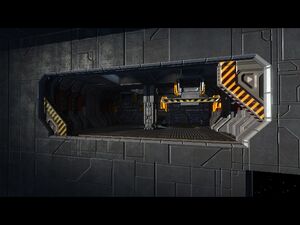
One of fourteen hangars possessed by the ship. This one, Portside Alpha, has been converted into a supply launch hangar for Albatross dropships.
Internally, its original configuration took into account contemporary designs of the time. Artificial gravity had yet to be developed, so an analogue was provided by a rotating section along its ventral hull, providing the equivalent of 1g to prevent spaceflight osteopenia. After the incorporation of artificial gravity, this section was rendered obsolete, and replaced by extensive barracks for passenger capacity, as well as cryonic storage bays and storage bays. After its 2526 refit, launch bays for ODST SOEIV pods were installed, taking up three decks – each launch tube can launch five pods, usually in staggered waves by company, with a combat company launched first, then the H&S Company, and then the rest of the battalion, maximising the amount of space they occupy along the external hull.
Like most of the Herald-class, the Aeneas was originally designed for movement in three dimensions, with numerous vertical or even diagonal corridors. Some of these corridors are retained to maximise the internal efficiency of the ship, but most of the decks are fitted with artificial gravity plating equivalent to 1g to accommodate traditional human sensibilities, and to remove the need for a rotating section mounted to the ventral hull. The result prevents bone osteopenia, and allows easier physical orientation. Most of the decks were built from scratch during its refit, having been almost completely gutted during its partial decommission, and possessed three extra decks that were included after unnecessary electronics systems were removed, and the deck height was reduced, there no longer being a need for the extra safety space – the arrangement was partially based on that of the Halcyon-class cruiser, featuring an intricate internal network of titanium-vanadium bracings and compartmentalised sections to allow damage to the ship to be lessened and isolated. The ships bridge is located in the centre of the ship, surrounded by reinforced layers of titanium-vanadium bracing, ensuring maximum survivability. A Combat Information Centre exists for personnel to coordinate with other ships, relay and receive ship or troop movements, or in the event that the bridge is incapacitated, serves a failsafe bridge. A small tower juts from the dorsal hull, housing advanced sensory equipment – while these are functional, they were originally added as decoys, providing enemy ships another reason to attack from above, bringing them into range of the laser turrets. The primary sensors are built into the stern, between the MAC’s, though each shot interferes with their effectiveness, resulting in the secondary sensors being functional.
In terms of capacity, the Aeneas carries enough supplies to operate independently for up to six months, even at full complement, carrying an entire division. Nonessential personnel are kept in cryonic stasis to conserve space, supplies, energy and the ships ability to filter and recycle atmosphere. The Aeneas possesses fourteen hangar bays, though they make more effective use of space than other ships. Under normal conditions, the “ceiling” and “roof” both possess gravity, allowing both halves of the hangar to be used independently of each other, though interaction of the two fields can put stress on craft. During launch conditions, however, the gravity is reoriented 90 degrees so that dropships, shuttles and fighters “drop” out of the hangar, removing the need for takeoff thrusters. Dropships and shuttles are stored to the sides, while the “floor” and “ceiling” each allow a Longsword to dock. Originally, the Aeneas carried Shortsword atmospheric bombers for launch against ground targets, but the installation of the more effective THORWS and the need for additional point defence saw them replaced. Functionally, the Aeneas only uses six of its hangars, maintaining twelve Longswords and up to sixty Pelican and Albatross dropships. The remaining hangars are used for equipment, supply and personnel storage, increasing the Aeneas’ loiter time away from UNSC supply lines.
Locomotion[]
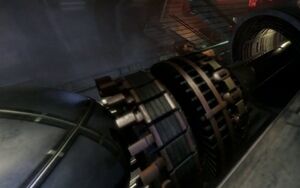
Though 40% larger than its predecessors, the SFTE-42 was marginally faster but 100% more accurate.
The Herald-class was originally meant to pioneer the use of Orion nuclear propulsion drives, but these were replaced with two less controversial and more conventional chemical thrusters, arrayed in a vertical configuration. After its 2490 overhaul, these were modernised to improve acceleration and efficiency, and another four were added, mounted to the port and starboard aft hulls. After its 2549 refit, these were replaced entirely by six Hall Effect thrusters, improving its acceleration and efficiency significantly. Along the rest of the hull are chemical rocket rotational control system thrusters, allowing the Aeneas precise control over its yaw, pitch and roll during manoeuvres. Two emergency thrusters on each lateral surface allow emergency course corrections, which another two thrusters on the bow allow sudden decelerations – in combat, this gives the Aeneas considerable agility, improving its evasive manoeuvres. For slipspace travel, the Aeneas uses a modernisation of the Shaw-Fujikawa Translight Engine using slipspace calculations recovered from crashed Covenant drives – it boosts the velocity a small amount, from 2.625 light-years per day to 2.71, not much of an improvement, but its most advantageous features are its improved efficiency and its dramatic increase in exit accuracy.
Armament[]
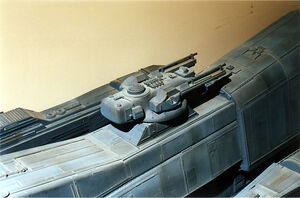
One of the ship's two LX224 DFL turrets, used in precise point-defence.
Along its dorsal hull, towards the bow, are a pair of LX224 deuterium-fluoride laser turrets, capable of rotating 360 degrees, and adjustable inclination/declination. Studies conducted by ONI showed that for a warship intended for geostationary orbit above a planets surface, the majority of threats were angled downwards, against the dorsal hull, as enemy ships travelled toward the planet. These are intended as point defence weapons, targeting and destroying minor threats, such as fighters, dropships and boarding craft, far more effective at penetrating enemy shields. These turrets have a 360 degree range of fire laterally, but cover only 180 degrees vertically. Along its port, starboard and ventral hulls are twenty conventional 50mm Close-In-Weapon-System autocannons, used to engage targets coming from directions out of the range of fire. The Aeneas also possesses twenty six standard sized archer missile pods, as well as two Magnetic Accelerator Cannons mounted on the bow running the full length of the ship, similar to a UNSC Destroyer, but located side-by-side rather than one-over-the-other. The longer acceleration tube allows higher velocities, and an efficient energy recapture system allows each MAC to fire two shots per charge, a 200% increase over standard MAC’s. Specialised launchers on the dorsal hull are capable of firing missiles with variable payloads – Fenris, Shiva or HAVOK warheads – at high speed.
Defences[]
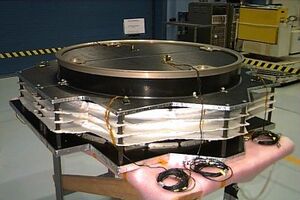
One of hundreds of whipple shields that cover the ships outer hull, protecting it from everyday wear-and-tear from micro debris.
Supplementing its defensive capabilities, the Aeneas augments its battle plate with an innovative system known as the SS-X CEMPF – a condensed electromagnetic protective field. While not a true energy shield, it drastically improves a ships survivability, especially against Covenant plasma torpedoes. When operated in non-combat conditions, the CEMPF can deflect or reflect most minor space debris, and even low-velocity kinetic projectiles. However, when a plasma torpedo enters the CEMPF, the two fields interact – the CEMPF is temporarily lowered in the area where the torpedo approached, while the torpedoes containment field collapses, allowing the plasma to harmlessly disperse, rendering the first shot useless. A second shot can penetrate the lowered field, but rotating the ship to face the vulnerable area away can reduce the effectiveness of this tactic. The CEMPF does little against particle beams, and nothing against laser weapons, but is significantly increases survivability. The actual hull is a ceramic-titanium composite covered with hundreds of whipple shields forming a mosaic-like pattern across the ships exterior, increasing durability and density, able to withstand multiple hits.
While the Aeneas utilised a pre-existing hull, its superior performance convinced the admiralty that the results of Project EXCALIBUR were worth incorporating into the entire fleet. A massive modernisation program was planned to begin in late 2552, with the entire fleet featuring the upgrades by 2554 – the devastation of Reach and the subsequent invasion of Earth by the Covenant before this could begin forced the Navy to mothball the idea until 2555, as it began to rebuild its strength. The technology pioneered by the Aeneas would also be incorporated into the Audacious-class battleship, which entered service during the Second Battle of Earth in 2552.
Commanding Officers[]
| Name | Rank | Service Time | Later Service |
| Horatio Cain | Captain (UNSC Merchant Marine) | 2421 - 2442 | Retired to civilian life. |
| Jeremy O'Reilly | Captain (UNSC Merchant Marine) | 2442-2462 | Retired to civilian life. |
| Natalie Stutt | Commander/Captain(UNSC Navy) | 2464 - 2527 | Promoted to Rear Admiral, transferred to UNSC Galadriel. |
| Karl Aedes | Commander(UNSC Navy) | 2527 - 2534 | Promoted to Captain, transferred to UNSC Lacrimosa |
| Gerald Wellers | Commander(UNSC Navy) | 2534 - 2535 | Court martialled for treason, dereliction of duty, and cowardice. |
| Jonathan Stanley | Captain(UNSC Navy) | 2549 - 2552 | Currently serving. |
Quotes[]
- "I saw the Aeneas during its 2526 tour of duty in Epsilon Indi. It was a bucket of bolts then. How the hell does it stay together now? There's the cryo-chambers, and the MAC at the bow...after that, everything else was substandard. I'm surprised they even recommissioned her - the Herald-Class ships were dropped in the first place because it was more economical to simply build new ships, rather than keep them properly maintained."
- "People gripe and moan about how Carriers are poorly armed for their sizes. They're supposed to be! That's why we still keep frigates and destroyers!"
- "I've had the honour to see both the refitted Herald-class and the Audacious-class battleship, the Warspite, in action. To be honest, I'd rather be aboard the Warspite - but if I were a Marine, the Aeneas would be my guardian angel."
- "If you'd seen her at Minorca, you wouldn't have believed your eyes - dropping troops and supplies even in the midst of a plasma bombardment, swatting Seraphs and boarding craft like flies, and dodging enemy fire like a ballerina. I don't know how much of that was the captain, and how much was the ship, but all I can say is that if we had more ships like this, the UNSC would still have Reach, and a dozen more colony worlds."

